As you wander away from the lively streets of Palermo’s old town, a starkly different experience awaits beneath the city’s surface.
The Capuchin Catacombs, or Catacombe dei Cappuccini, offer a solemn glimpse into the past, where tourists now tread paths once reserved for mourning loved ones.
Here, in the quiet corridors lined with the slowly decaying remains of over a thousand bodies, a unique connection to Sicily’s rich history persists.
Our visit to these catacombs, the final highlight of our Sicily Road Trip, was eerie and enlightening, a little like our visit to Serbia’s Nis Skull Tower.
Come along with us as we delve into why the Capuchin Palermo Catacombs (Cappuccini Catacombs Palermo) should be on the itinerary of every traveller intent on experiencing the full breadth of Sicilian history.
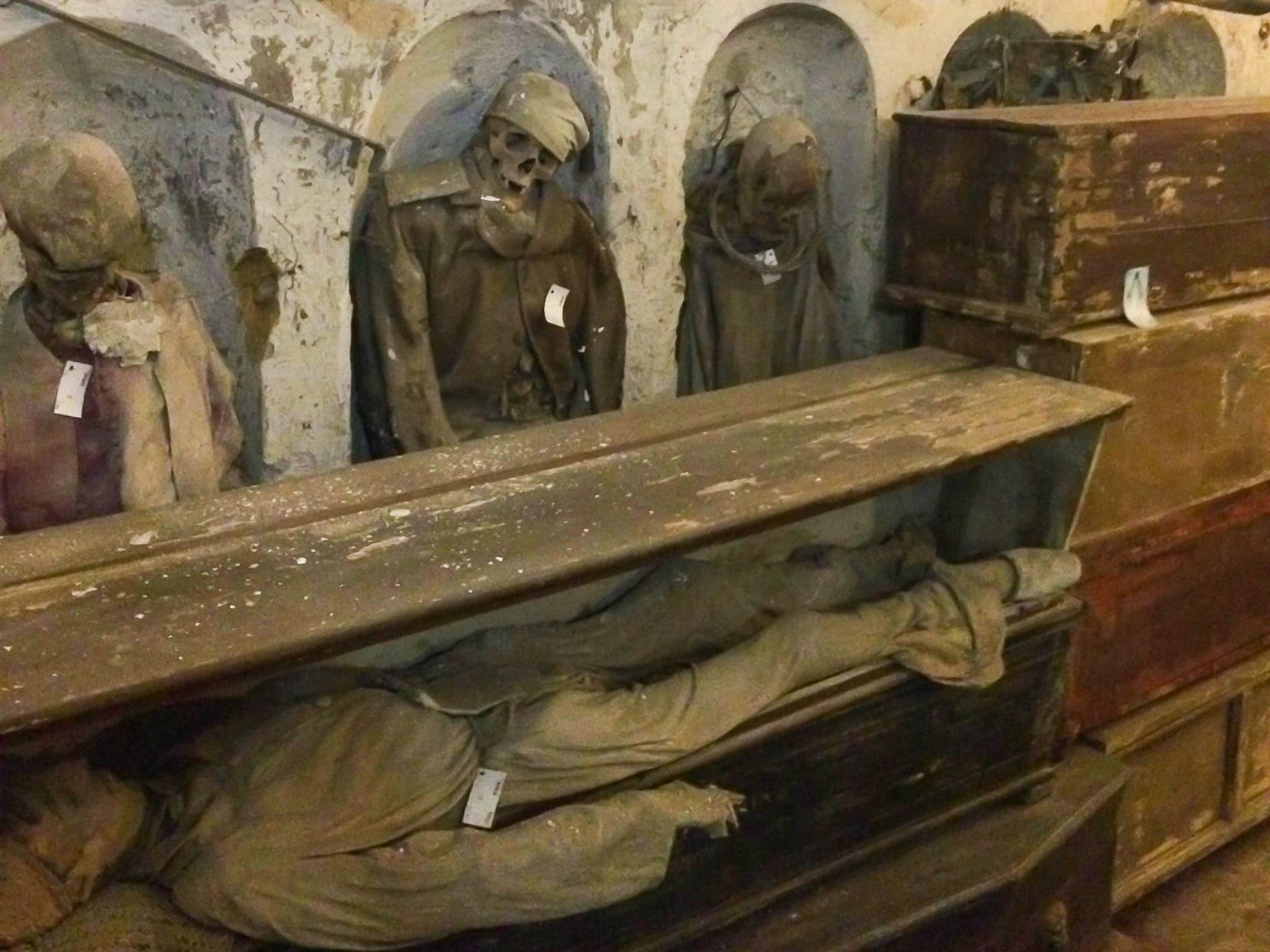
Palermo Capuchin Catacombs in a Nutshell
Discover the eerie corridors of the Palermo Catacombs, home to over 1,200 mummified bodies. Initially started by the Capuchin monks in 1599, these catacombs are a fascinating testament to Sicily’s rich history and the monks’ mummification techniques.
Don’t Miss:
- The perfectly preserved body of Rosalia Lombardo, the ‘Sleeping Beauty of Palermo.’
Learn more about Sicily’s unique attractions in our Sicily Road Trip Itinerary.
Visitor Information for the Palermo Capuchin Catacombs
Opening Times:
- The catacombs are open daily from 9:00 AM to 12:30 PM and 3:00 PM to 5:30 PM, including holidays. They are closed on Sundays from late October to late March.
Admission Fee:
- Entry costs €5 per person, but we recommend this ⭐️ 5-star reviewed guided tour to learn about the catacombs and some characters within.
Visiting Rules:
- Photography is strictly prohibited within the catacombs to protect the mummies’ preservation and respect the site’s sanctity. If you are caught taking photos, a monk will ask you to stop using a loudspeaker.
- Please maintain a quiet demeanour throughout your visit to respect other visitors and the restful nature of the site.
- Do not touch the bodies or any displays to help preserve the integrity of these historical artifacts.
Additional Tips for First-Time Visitors:
- Wear comfortable walking shoes as the ground can be uneven.
- The temperature inside the catacombs can be cooler than outside, so consider bringing a light jacket.
- Due to the potentially disturbing nature of the exhibits, the visit might not be suitable for young children or those sensitive to such displays.
- Allow an hour to fully appreciate the site and its historical significance.
- Read up on the history of the Capuchin Monastery Catacombs before you arrive, as there are no guided tours or information boards to explain the exhibits. (Which is why a guided tour is a great idea)
If you’re planning more Italian adventures, consider campervanning through the country. Our Guide to Campervanning in Italy provides essential tips and itinerary ideas for a flexible and varied travel experience.
Map: Navigating to Sicily’s Capuchin Catacombs
Exploring the Capuchin Catacombs of Palermo
A Cool Gaze Into the Past
Step into the shadowy corridors of the Palermo Catacombs and feel the chill of history brush against your skin. As you walk through the narrow, sepia-toned hallways, the muted colours of the past surround you, creating an eerie, timeless atmosphere.
What does catacomb mean?: A catacomb is an underground cemetery, often in underground tunnels. It is not to be confused with a crypt, a hidden grave, often in the wall or under the floor of a church. Therefore, it is the Capuchin Monastery catacombs rather than the Palermo crypt.
The Capuchin Monastery catacombs contain around 1,200 mummies. Many are propped in individual stone cubicles along the walls, while others lie in glass caskets. Their eyes are closed, and some still have intact hair.
It is a little eerie, to say the least.
Having exhausted space in their cemetery, the Capuchin monks began this subterranean chamber in 1599 AD to house their brethren.
This burial method, alongside the catacombs’ intricate design, reflects a unique aspect of historic preservation and architectural ingenuity similar to other notable sites across Italy.
For those fascinated by Italy’s rich architectural heritage, the Trulli houses in Alberobello offer another remarkable example of unique construction techniques and cultural heritage. Discover more about these traditional cone-shaped stone huts, recognized as a UNESCO World Heritage site, in our exploration of Alberobello.
One of the original Capuchin monks, Brother Silvestro of Gubbio, was the first to be interred in these Sicily catacombs.

Mummification and Social Status
After initially serving to preserve members of their own brotherhood, the monks’ effective techniques meant that by the 18th and 19th centuries, the catacombs became a favoured burial place for wealthy Europeans and Sicily’s elite.
In the Palermo Catacombs, corpses are dressed in clothes reflecting their societal status. The catacombs house clergy and high-ranking professionals, and there are corridors specifically for men, women, virgins, and children.
Mummification was practised to preserve and uphold one’s status and dignity after death.
Thus, priests are adorned in their clerical robes and affluent merchants in their finest clothes, showing that their societal roles continue to be recognized even in death.
Exploring the Catacomb Corridors
As you explore, you’ll find that the catacombs are divided into several sections, each telling a unique story.
The Men’s Corridor features monks in simple robes, while the Women’s Corridor showcases elegantly dressed women, some wearing crowns or holding palm branches.
The Virgins’ Corridor and Children’s Corridor highlight how age and innocence were viewed in death.
The Professors’ Corridor includes mummies of doctors, lawyers, and artists, reflecting their societal roles even in death.
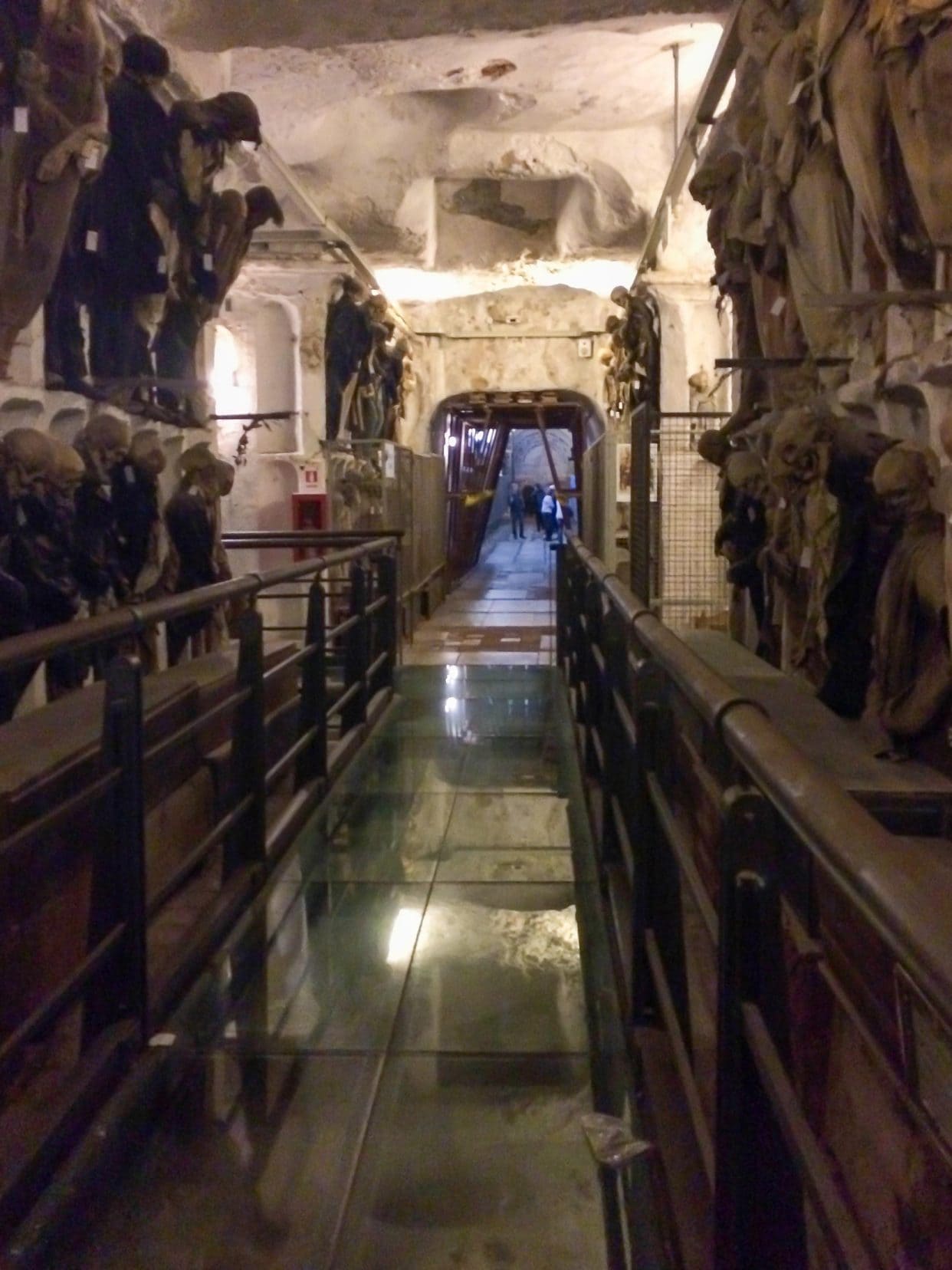
Planning a Trip to Italy?
- 🚗 Hiring a car? We recommend getting a quote from DiscoverCars
- 🚐 Hiring a campervan? We recommend Motorhome Republic
- ⛑ Arranged your travel insurance? Compare quotes from World Nomads & Safetywing
- 🪪 Order your International Driver’s Licence online here
- 🏩 Booked your accommodation? We use Booking.com to find the best deals
- 🐾 Is someone pet-sitting for you? 🐾 We use and love TrustedHousesitters
- (Get 25% off at checkout for new memberships with our discount code: LIFEJOURNEY25)
The Sleeping Beauty of Palermo: Rosalia Lombardo
The Catacombs are not just a resting place for adults. The poignant ‘Chapel of Children’ holds the small bodies of young lives cut short.
Rosalia Lombardo
Among the youngest of these bodies is Rosalia Lombardo. She died of pneumonia and was interred here in the 1920s at just two years old.
Known as the ‘Sleeping Beauty of Palermo,’ Rosalia was born to a wealthy family. Her father, overcome with grief from her death, enlisted taxidermist Alfredo Salafia to preserve her forever.
Today, Rosalia’s perfectly preserved body rests in a glass cabinet, appearing so lifelike that she seems merely asleep. Her exceptional preservation has made many regard her as the world’s most beautiful mummy.
Preservation Techniques at the Catacombs
The mummification process in the Capuchin Monastery Catacombs combines natural environmental conditions with sophisticated techniques developed by the Capuchin monks.
The catacombs’ dry, stable climate naturally helps to dry out the bodies and slow decomposition.
The monks placed bodies on ceramic pipes to promote air circulation and applied natural balms and resins, achieving a remarkable state of preservation that continues to astonish scientists and historians.
Over the centuries, the monks refined their methods, introducing arsenic-based solutions and other chemicals to preserve soft tissues and inhibit bacterial growth.
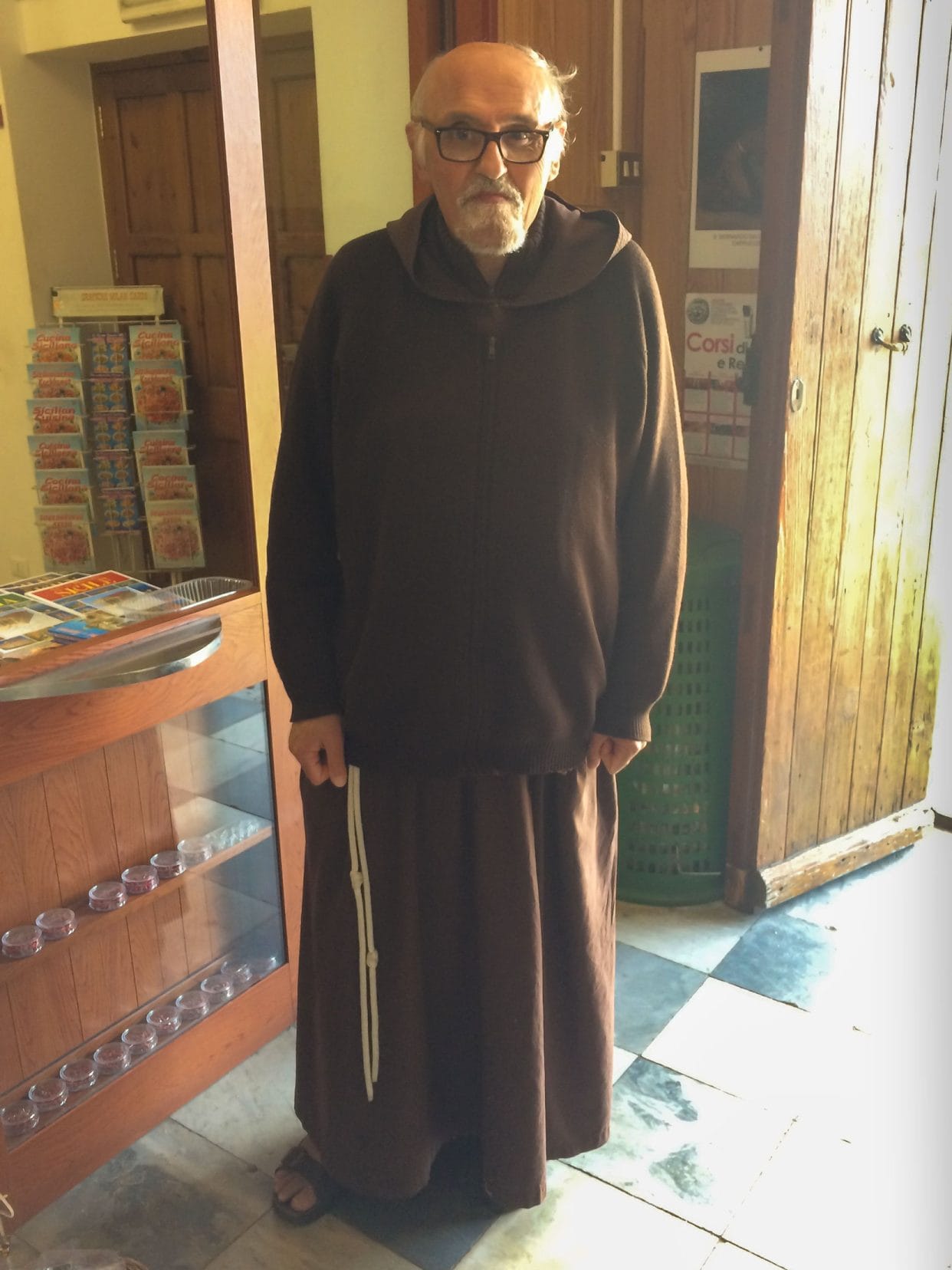
Deciphering the Palermo Catacombs: Meaningful Heritage or Mere Macabre?
Tourism and Its Impact on Sacred Sites
The Palermo Catacombs, initially a site for family members to visit and honour their deceased loved ones, have transformed over time. Originally, families would dress the bodies in new clothes and maintain them carefully.
Their loved ones and family members could visit them and even hold their hands in prayer.
However, if families could no longer afford this upkeep, the bodies were moved from prominent display to less visible shelves. This personal connection to the deceased provided deep meaning for their families.
However, as time has passed, these intimate rituals performed by loved ones have been replaced by voyeuristic tourists.
So, are these Sicily Catacombs just a gruesome gathering of corpses that attract those looking for a macabre experience?
Is it simply curiosity that draws us in here?
Whatever our motivations for visiting the catacombs of Palermo, we are participating in what is termed ‘Dark tourism‘.
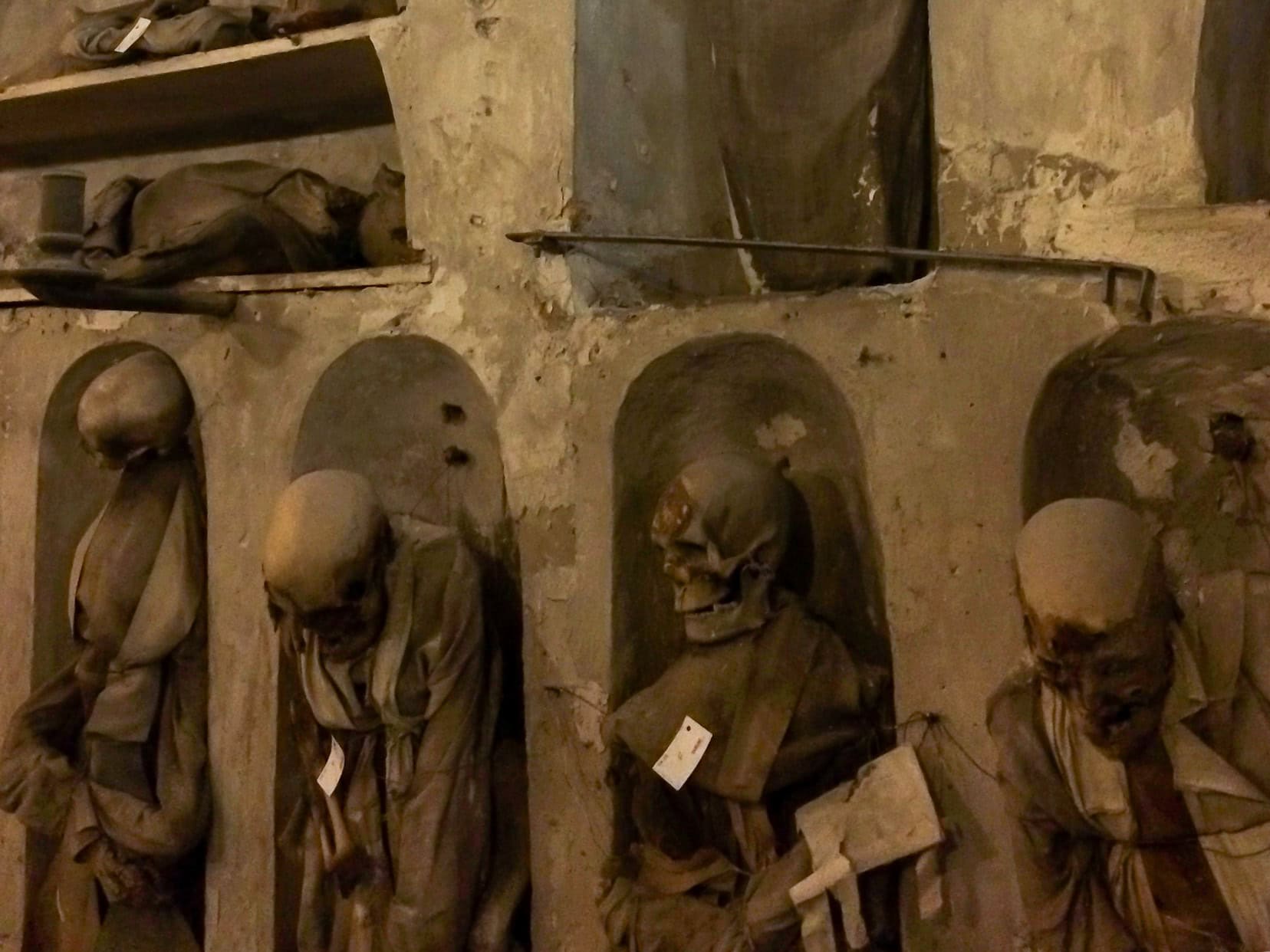
The Ethical Debate: Preservation vs. Display
The ethical implications of displaying human remains are complex. One could argue that these dead souls are giving meaning in new ways.
In 2022, Kirsty Squires from Staffordshire University, UK, along with Dario Piombino-Mascali of the Sicily Mummy Project, initiated a study on 163 child mummies in the Palermo Catacombs.
Using modern techniques like X-rays and CT scans has uncovered that despite their balanced diets, the wealthy individuals buried here suffered from diseases like gout and skeletal disorders.
Despite the controversies, the work continues to provide valuable insights, suggesting that the preserved remains of the past still play a vital role in our understanding of history and human health.
These efforts highlight an ongoing dialogue about the balance between preserving heritage and respecting the deceased’s dignity.
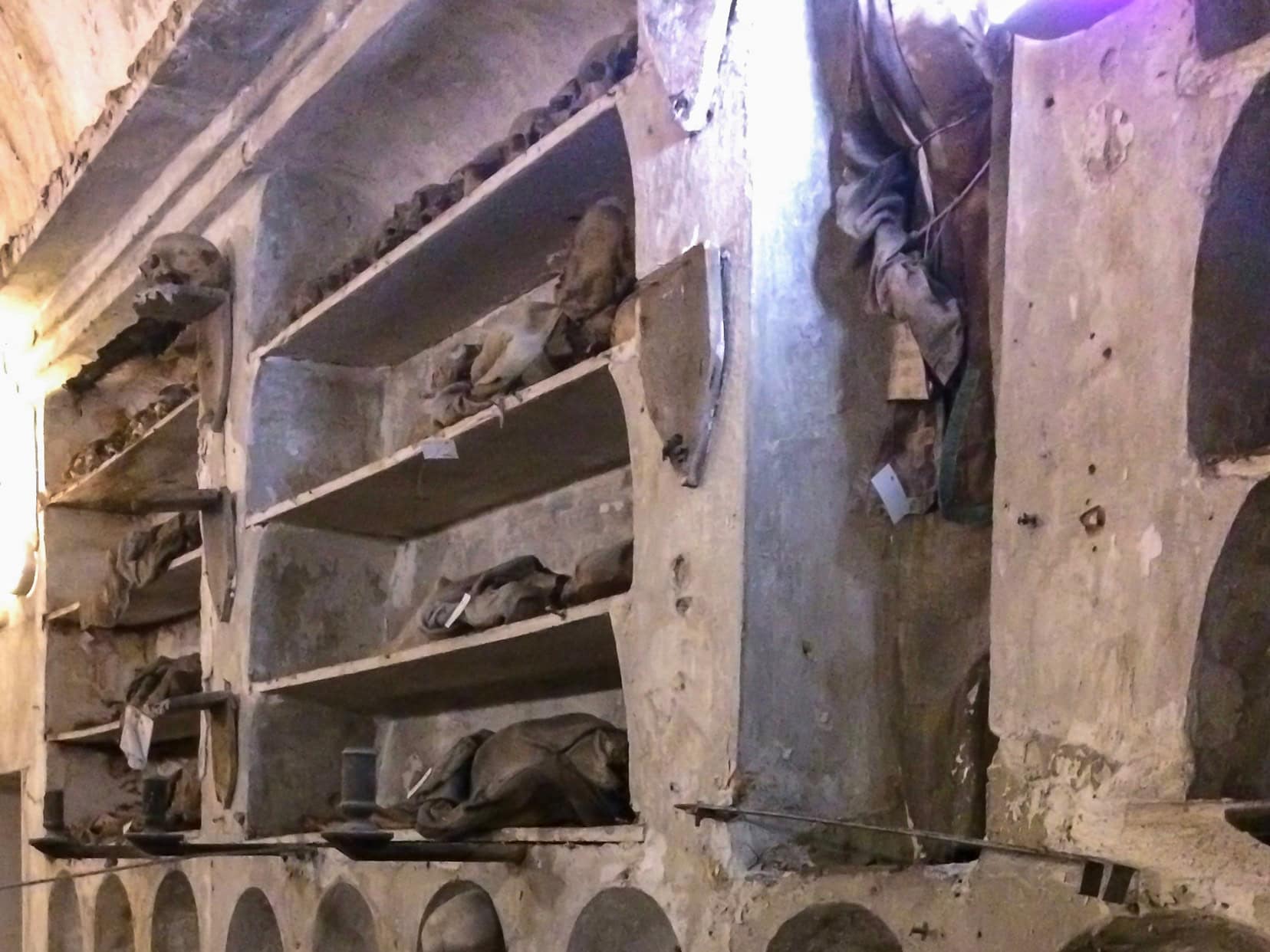
Meet the Capuchin Monks: Guardians of History
The Franciscan Connection
The Capuchin Monks are a Catholic religious Order of priests and brothers inspired by St Francis of Assisi, which formed in the 16th century.
They wear simple, plain, dark brown robes, and the term cappuccino is said to have originated because the colour resembled that of the Capuchin monks’ robes.
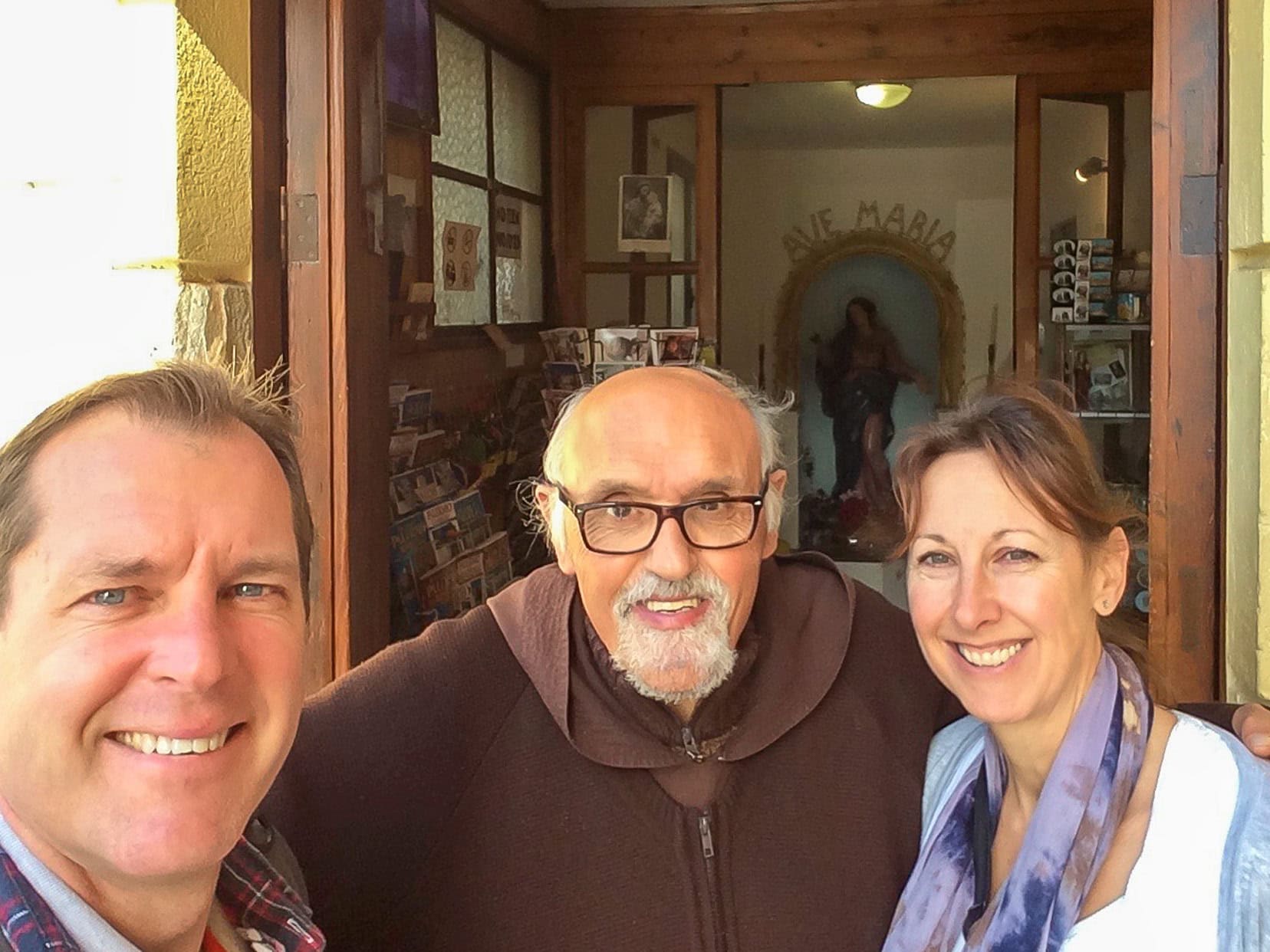
Cultural Influences: From Coffee to Monkeys
Interestingly, the Capuchin monkey is also named after these monks. The resemblance comes from the monkeys’ facial colouring and hood-like fur, mirroring the monks’ hooded robes.
After watching the capuchin monkeys in the Monkey Sanctuary at Plettenberg, South Africa, we can see why the name lends itself to these monks, resembling the monks with their hoods down.
Getting to the Palermo Catacombs: Tips and Directions
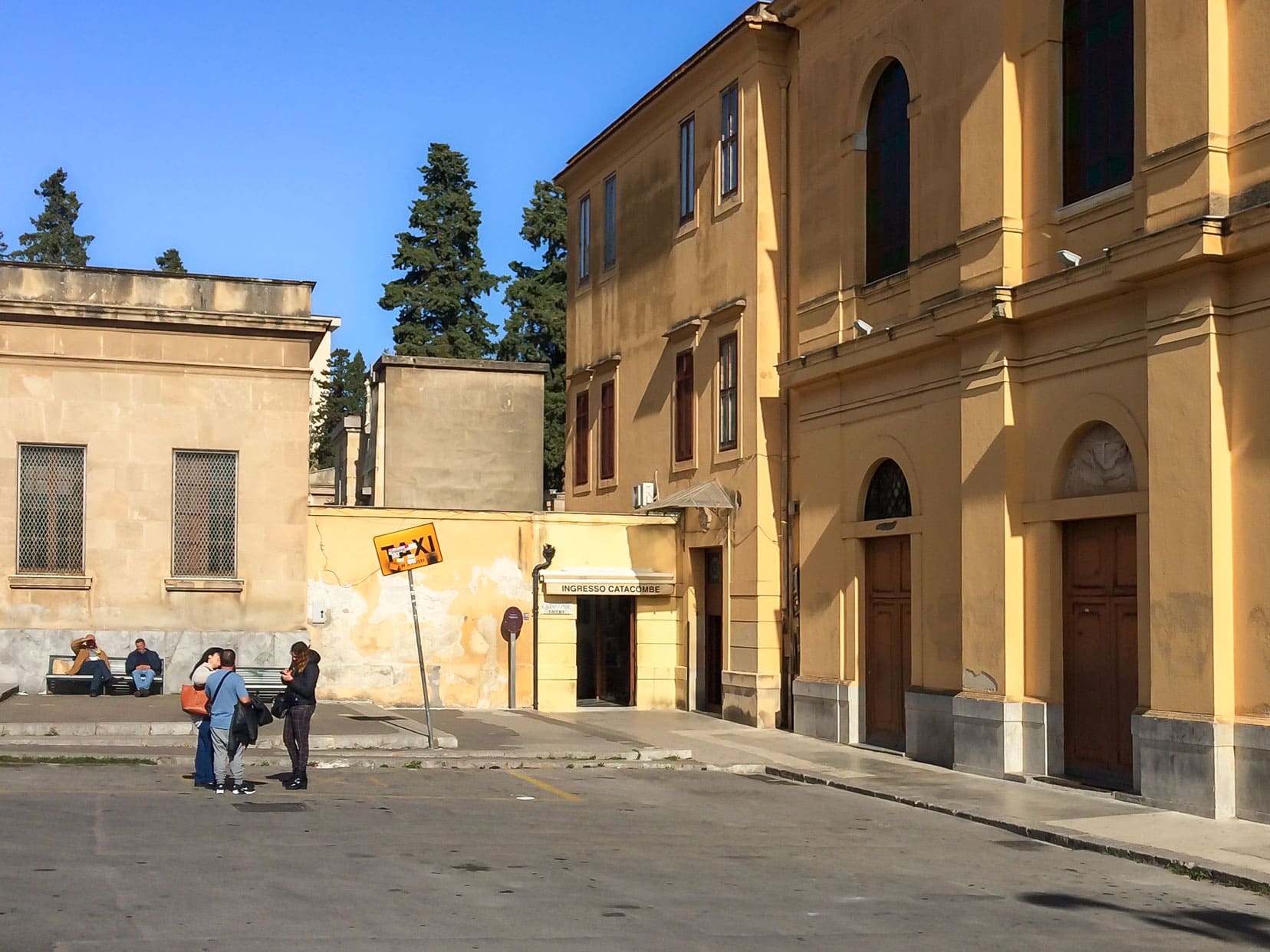
Public Transport Options
By Bus:
- Take Bus 109 or 318 from Central Station to Piazza Indipendenza. From there, take Bus 327 or walk along Via Cappuccini for about 15 minutes. At the first intersection, turn right onto Via Pindemonte and continue straight to Piazza Cappuccini.
By Train:
- Alight at Palazzo Reale-Orleans station. Walk towards the Norman Palace (or Royal Palace), cross Independence Square, and proceed along Via Cappuccini. Take the first right onto Corso Calatafimi and continue to Piazza Cappuccini.
Getting to the Catacombs By Car:
Drive to the Capuchin catacombs of Palermo, where parking is available in the square outside the entrance.
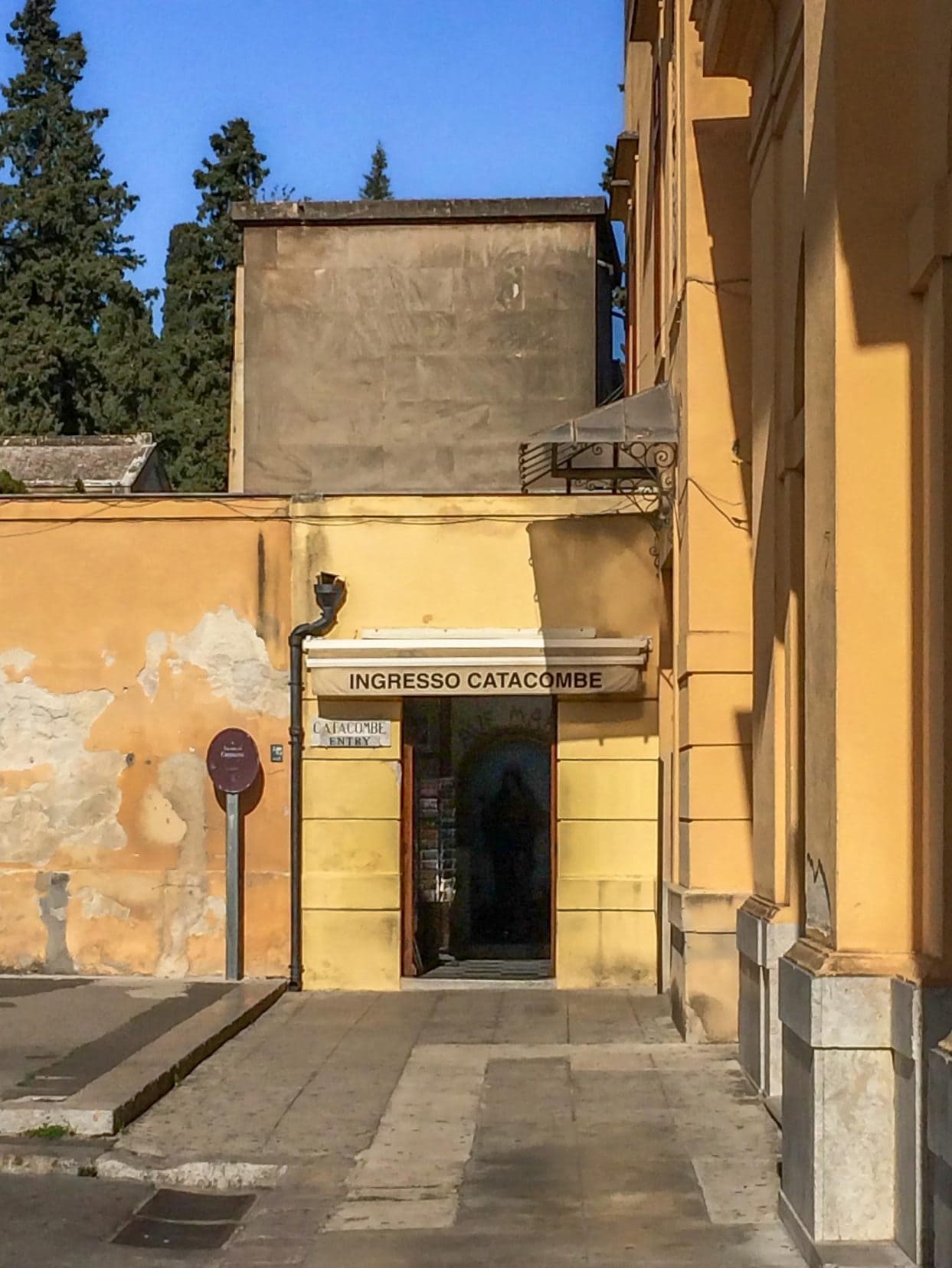
Frequently Asked Questions
1. Can you visit the catacombs in Palermo?
Yes. The Palermo catacombs are open from 9:00 AM to 12:30 PM and 3:00 PM to 5:30 PM every day and closed on Sundays from late October to late March.
2. Are the catacombs in Palermo real?
They are 100% genuine. The first internment dates back to A.D. 1599 with the last around A.D. 1920.
3. How many bodies are in the Palermo catacombs?
There are approximately 1200 mummified bodies in the Palermo catacombs.
4. Who is the mummy in the Capuchin Catacombs in Palermo, Sicily?
The most famous mummified body is that of Rosalia Lombardo, a 2-year-old girl who died of pneumonia. She is known as the ‘Sleeping Beauty of Palermo’ because she looks as if she is asleep.
Palermo Catacombs … That’s a Wrap
Our exploration of the Palermo Catacombs invited us into a complex labyrinth where each mummy unveiled the multifaceted layers of human endeavour and mortality.
Beyond just relics, these Capuchin catacombs challenge us to confront our views on death and wonder why this visit interested us. I’d like to think curiosity alone made the trip so interesting, but maybe the macabre also played a role.
The catacombs are places of historical significance that echo an important part of Sicily’s past.
Whether driven by curiosity, the gruesome or a love of history, the Capuchin catacombs provide a unique experience in Palermo, Sicily, urging us to delve deeper into the region’s rich history.
If this exploration of the Palermo Catacombs has inspired you to discover more of Sicily or Italy by road, planning your journey can enhance the experience, allowing you to uncover even more hidden gems. Our guide on How to Plan a Road Trip offers valuable tips and tools for creating the perfect itinerary that fits your travel style and interests.
For an even easier planning process, download our Free Printable Road Trip Planner, packed with checklists and planning sheets to help you organise an unforgettable adventure.
As you leave the shadowy corridors of the catacombs behind and step back into the Sicilian sunlight, the echoes of the past invite you to explore further, weaving the threads of history into your travel tapestry.
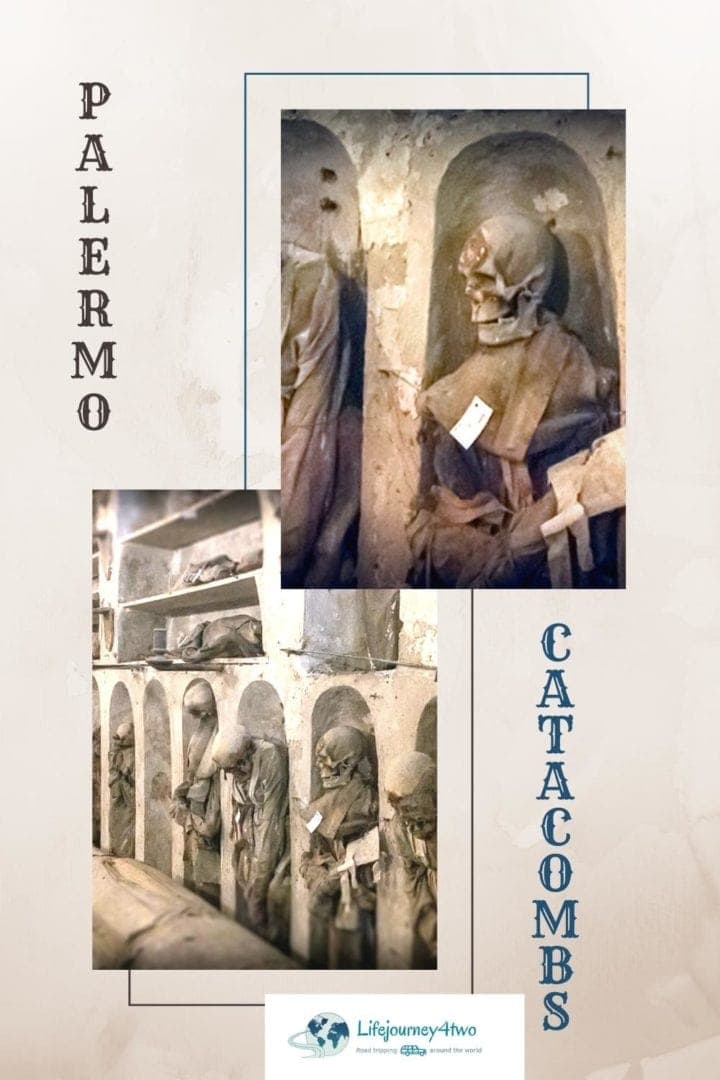
Planning Your Travels?
These are the travel resources we recommend and use when planning our trips.
- 🚘 Car Hire: We use DiscoverCars.com
- Motorhome/Campervan Rental: We highly recommend the Motorhome Republic
- 🪪 Order your International Driver’s Licence online here
- 🛏 Book Accommodation: We use Booking.com to find accommodation that suits our budget
- 🐶 Pet Sitting/Pet Sitters: Check Out TrustedHousesitters here (Use our Discount code: LIFEJOURNEY25 for 25% off. )
- Activities and Experiences: Get Your Guide and Viator
- Travel Insurance: Safetywing or World Nomads
- 🥾 Travel Gear and Accessories: Check out our top picks here — Lifejourney4two page on Amazon
For a more thorough list, visit our Travel Resources page here.

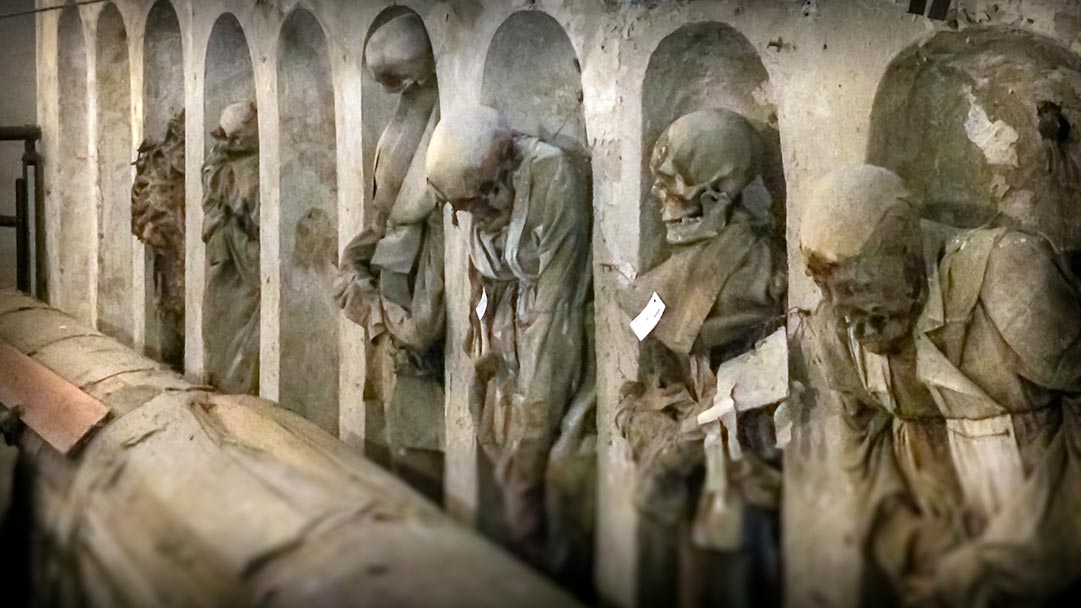

Do you need a reservation or buy ahead ticket for viewing in October on our visit there.
Catacombs
Hi Carol
Thanks for your email. I just checked their website and it says they are closed at the moment (Trip Advisor reviews say that they are closed for renovations.)
You may wish to check nearer the time for opening times … here is the link:
http://www.palermocatacombs.com/visit/opening-hours
If they are open, you don’t need to book ahead. Just turn up and pay the admission (about 3 euros).
What a great article. Sicily is on our five year bucket list and this has given us some great ideas. A Moreton Bay Fig tree!! Growing up in Redcliffe, Australia I would not have thought I’d see one in Sicily 🙂
Melissa xx
Thanks Melissa, I know, we felt the same about the fig tree … and it was certainly a fine figure of a tree;) We loved Sicily, it was warm, even though winter, and there was so much to see and enjoy. Look forward to hearing about your travels there 🙂
Thanks for sharing your visit to Palermo. We have only done one quick day trip in Sicily from a cruise but it is on our plans for a much longer return trip. We are hoping to do Sicily and Sardinia one year. The oldest tree looks fascinating. But the catacombs might leave me with nightmares. Love a city you can walk around. If we were planning a trip, how many days should we set aside for Palermo?
Hi Linda,
Lovely to hear from you. Yes, we really enjoyed walking around the old town in Palermo where there was plenty to see. We did it in a day but we didn’t go into all the churches and cathedrals. At least two days would probably be less rushed. The catacombs were portrayed in a respectful manner and very interesting. The monk at the entrance was friendly and willing to explain all about the history of the place. If you have any more questions we are happy to help out.